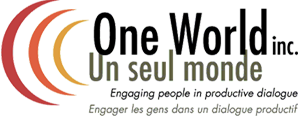How Theory of Change Helps Organizations Address Complex Social Issues
 Like a roadmap guides motorists through unfamiliar territory to reach the final destination, there are effective tools that can help organizations to better navigate the complex environments in which they work, and guide the development of successful initiatives. And just as a map is altered as landscapes evolve, so too should the tools used to help us understand complex issues.
Like a roadmap guides motorists through unfamiliar territory to reach the final destination, there are effective tools that can help organizations to better navigate the complex environments in which they work, and guide the development of successful initiatives. And just as a map is altered as landscapes evolve, so too should the tools used to help us understand complex issues.
Leaders in the government, not-for-profit and community outreach sectors are realizing that many of the tools that helped in the past are no longer appropriate to understanding complex issues today. Think, for a moment, about the significant issues of our time—issues such as poverty, homelessness and crime. These are large-scale challenges for which there is no single cause-and-effect and, as a result, no single solution.
Logic models, which have been one of the most commonly used approaches to program planning, are less useful when the environment is more complex and the organization is moving into uncharted waters. One of the newer tools that has proven itself to be particularly useful in helping to map pathways of change for complex social issues is the Theory of Change.
The Theory of Change helps organizations to define the issues, goals, and preconditions to progress, and to evaluate and assess advancement towards those goals. It functions as a roadmap to guide the process and a mirror for ongoing and necessary evaluation. It also allows organizations to communicate their goals and progress in a clear, concise manner, which is useful in building coalitions of support around an issue.
Ottawa Uses Theory of Change to Address Crime Prevention
The Theory of Change has been applied to help address the issue of crime prevention in Ottawa. The organization, Crime Prevention Ottawa (CPO), sought to apply a community-based approach to crime prevention as opposed to the more traditional crime prevention strategies that focused on enforcement. They funded community-based crime prevention projects in three Ottawa neighbourhoods, and were looking for an approach to capture the learnings from these projects and evaluate their success. One World Inc. helped CPO to develop a Theory of Change that was very useful as a framework to learn from this experience and to communicate the approach to other important stakeholders, such as City Council.
Step One: Identify Long-Term Goals
In developing a Theory of Change roadmap, the starting point is always the question: What is the main, long-term goal you want to achieve? This is, in fact, an essential piece of homework that is given to clients at the outset of a Theory of Change process. In the case of CPO, the primary goals were to decrease the incidence of crime in the community, and increase feelings of safety. Once the CPO had determined what it wanted to achieve, the next step was to identify the preconditions that had to exist before the long-term goals could be achieved.
Step Two: Backwards Mapping of Preconditions for Success
The second step in any Theory of Change process involves the backwards mapping of preconditions for success, which involves several rounds of discussion with a variety of stakeholders. This is when the whole endeavour begins to take shape and the big picture of how preconditions are interrelated and ordered emerges. In the case of the CPO, the preconditions identified to meet the two main goals were:
- Present a safe and welcoming physical environment. Research has demonstrated that the physical environment can have a significant impact on criminal behaviour. Residents feel safer and are more likely to leave their homes and engage in outdoor activities and meet their neighbours when their neighbourhoods are well-lit, well-maintained, and where they know other people are present.
- Have actively engaged residents. Local residents need to be aware of opportunities to get involved in community events to join organizations. They must be encouraged and supported to engage locally. And fundamentally, they must feel that they can “make a difference” through their engagement.
- Have actively engaged and responsive partners. Social agencies and community organizations working in the neighbourhood, such as health centres, tenant associations, and community associations, need to actively and demonstrably listen and respond to community members. There needs to be a sense of partnership and fruitful interaction.
One of the insights that came to light during this process was that in order to feel safe, citizens needed to have strong community connections so that isolationist feelings could not arise. If people in the community felt crime was an important issue, but were isolated from one another, it was unlikely that they would be able to take meaningful action towards crime prevention.
By going through this road mapping process, actively engaged volunteers and community leaders were able to understand how these three preconditions related to the larger end-goal. The Theory of Change framework provided a much better sense of where and how different parties could intervene and how their interventions might be successful.
Mapping The Results
After several years of community-building and crime prevention, the communities of Lowertown, Pinecrest-Queensway and Vanier have been transformed through the focused efforts of local residents and their community partners—people who cared enough to make a difference and to work together to achieve positive change. From social agencies to police, local businesses and community leaders, their combined efforts stand as a testament to the commitment to safety that exists in each community and the effectiveness of the Theory of Change model.
Although the Theory of Change provided a common framework for the work, the richness of the project was how each of the three communities developed its own approaches designed to fit with the local context, culture, and issues, making optimal use of local resources and volunteer energy.
The Contribution of the Theory of Change Process
The Theory of Change model provides communities and agencies with a tool to understand the process of change. It helps them to plan, focus and evaluate the impact of their work and monitor the success of their efforts. It also provides the various partners involved with a common framework within which to discuss the progress towards otherwise nebulous and difficult to define social development goals.
For CPO, a lower crime rate was the long-term goal, but everyone engaged in the process understood that moving the needle on that particular metric might not happen measurably over the short course of a year. The Theory of Change process helped establish measurements for many of the preconditions, some of which were measurable in the immediate-term.
The application and benefits of the Theory of Change are vast. It is one of the most effective tools for consultants to use to help organizations plan and evaluate their actions, and to foster understanding about an issue. Ultimately, the Theory of Change seeks to develop plans that are, indeed, carried out—but even more than that, it seeks to answer the most important question of all: “Did we achieve the impact that we set out to achieve?”
